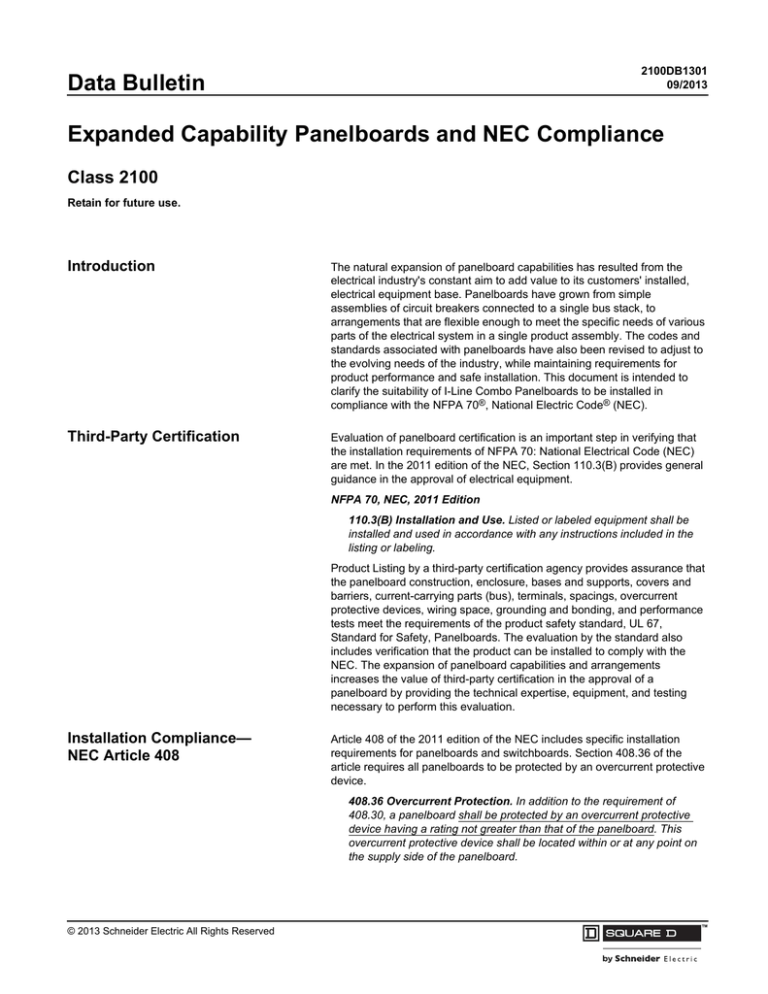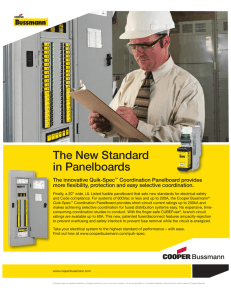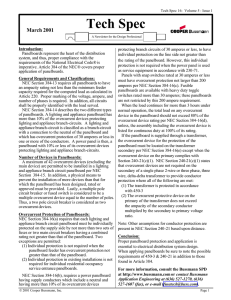
2100DB1301
09/2013
Data Bulletin
Expanded Capability Panelboards and NEC Compliance
Class 2100
Retain for future use.
Introduction
The natural expansion of panelboard capabilities has resulted from the
electrical industry's constant aim to add value to its customers' installed,
electrical equipment base. Panelboards have grown from simple
assemblies of circuit breakers connected to a single bus stack, to
arrangements that are flexible enough to meet the specific needs of various
parts of the electrical system in a single product assembly. The codes and
standards associated with panelboards have also been revised to adjust to
the evolving needs of the industry, while maintaining requirements for
product performance and safe installation. This document is intended to
clarify the suitability of I-Line Combo Panelboards to be installed in
compliance with the NFPA 70®, National Electric Code® (NEC).
Third-Party Certification
Evaluation of panelboard certification is an important step in verifying that
the installation requirements of NFPA 70: National Electrical Code (NEC)
are met. In the 2011 edition of the NEC, Section 110.3(B) provides general
guidance in the approval of electrical equipment.
NFPA 70, NEC, 2011 Edition
110.3(B) Installation and Use. Listed or labeled equipment shall be
installed and used in accordance with any instructions included in the
listing or labeling.
Product Listing by a third-party certification agency provides assurance that
the panelboard construction, enclosure, bases and supports, covers and
barriers, current-carrying parts (bus), terminals, spacings, overcurrent
protective devices, wiring space, grounding and bonding, and performance
tests meet the requirements of the product safety standard, UL 67,
Standard for Safety, Panelboards. The evaluation by the standard also
includes verification that the product can be installed to comply with the
NEC. The expansion of panelboard capabilities and arrangements
increases the value of third-party certification in the approval of a
panelboard by providing the technical expertise, equipment, and testing
necessary to perform this evaluation.
Installation Compliance—
NEC Article 408
Article 408 of the 2011 edition of the NEC includes specific installation
requirements for panelboards and switchboards. Section 408.36 of the
article requires all panelboards to be protected by an overcurrent protective
device.
408.36 Overcurrent Protection. In addition to the requirement of
408.30, a panelboard shall be protected by an overcurrent protective
device having a rating not greater than that of the panelboard. This
overcurrent protective device shall be located within or at any point on
the supply side of the panelboard.
© 2013 Schneider Electric All Rights Reserved
™
Expanded Capability Panelboards and NEC Compliance
Installation Compliance—NEC Article 408
2100DB1301
09/2013
The overcurrent protection requirement in section 408.36 is key to an
NEC-compliant installation. For a panelboard, this overcurrent protection
must not be greater than the marked rated current of the panelboard. This
requirement aligns with the performance testing and marking requirements
in the UL 67 product standard. It is important to remember that this
requirement applies to the overall rating of the panelboard and that bus
assemblies within may have reduced ampacity where marked.
Requirements for supplemental ratings within the panelboard are evaluated
as part of the product listing. Excerpts from the product standard, UL 67,
Standard for Safety, Panelboards, and the UL Marking and Application
Guide, Panelboards are shown below.
UL 67, Standard for Panelboards, Twelfth Edition, revisions through
January 11, 2013
29.1 The current rating of a panelboard shall not be more than the
smaller of the following:
a) The ampacity of the bus bars; or
b) The current rating of the main switch and fuseholders, or the
current rating - trip rating - of the main circuit breaker, except as noted
in 32.8.6; or
c) For NEC Article 705 applications noted in 5.6.11:
1) Supply side connections - The combined sum of the current rating of
all supply side disconnect(s) intended for connection to parallel power
sources. See 32.16.6.
2) Load side connections - The combined sum of the current rating of all
overcurrent devices supplying the panelboard.
Exception: The combined sum may exceed the rating of the bus bars, or
the rating of the main overcurrent device by up to 120% if overcurrent
device(s) are positioned as noted in 5.6.11(b), exception. See 32.16.5.
29.2 The current rating referred to in 29.1 is capable of being
supplemented by one or more reduced ratings, each applicable under
specified conditions - such as use of aluminum main conductors or a
main circuit breaker having a current rating less than the rating normally
required of the breaker - when the panelboard is marked in accordance
with 32.1.16.
32.1.16 The conditions under which each supplementary current rating
as mentioned in 29.2 applies shall be marked on the panelboard.
UL Whitebook—UL Marking and Application Guide, Panelboards,
January 2013
7. CURRENT RATING
The current rating of a panelboard is the maximum continuous current
that can be supplied through the main terminals. Unless the assembly,
including the overcurrent device(s), are marked for use at 100 percent of
their current rating, overcurrent protection devices should not be loaded
continuously to more than 80 percent of their rating if nuisance opening
of the overcurrent device is to be avoided. The current rating of a
panelboard may be supplemented by one or more reduced ratings, each
applicable under specified conditions.
2
© 2013 Schneider Electric All Rights Reserved
2100DB1301
09/2013
Expanded Capability Panelboards and NEC Compliance
Expanded Capability Panelboard Example
Expanded Capability Panelboard
Example
Figure 1:
Although I-Line Combo panelboards are different in appearance as
compared to traditional panelboards, compliance with the NEC is straight
forward where third-party certified product is installed per the product
marking and manufacturer's instructions. The example below illustrates how
a panelboard with expanded capabilities would be marked to comply with
the UL 67 product standard, the NEC, and third-party certification.
Section Rating Marking Location
Main Panelboard Ratings—Includes
maximum current and voltage of the
panelboard. This overcurrent
protective device, per NEC 408.36,
must be located within or at any point
on the supply side of the panelboard,
based on this rating.
Supplemental Rating—Reduced
ampacity section within the
panelboard marked with specific
conditions for use and evaluated per
the product standard in the
certification process or listing.
© 2013 Schneider Electric All Rights Reserved
3
Expanded Capability Panelboards and NEC Compliance
Data Bulletin
Figure 2:
2100DB1301
09/2013
Certification Mark Location
Third-party certification marking on the
product demonstrating compliance
with the UL 67 product safety
standard.
Schneider Electric USA, Inc.
1415 S. Roselle Road
Palatine, IL 60067 USA
1-888-778-2733
www.schneider-electric.us
4
Electrical equipment should be installed, operated, serviced, and maintained only by
qualified personnel. No responsibility is assumed by Schneider Electric for any
consequences arising out of the use of this material.
© 2013 Schneider Electric All Rights Reserved
Schneider Electric and Square D are trademarks owned by Schneider Electric
Industries SAS or its affiliated companies. All other trademarks are the property of
their respective owners.


